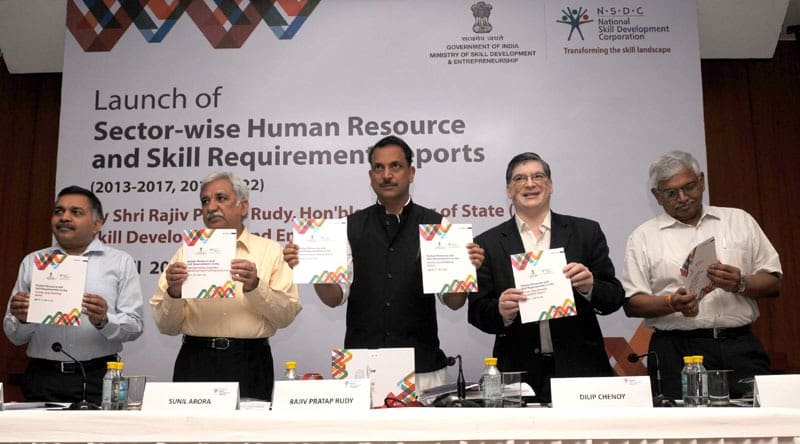Minister of State (Independent Charge) for Skill Development and Entrepreneurship Shri Rajiv Pratap Rudy here today launched the Human Resource and Skill Requirement reports across 24 sectors in India which will serve as the baseline for all skill development initiatives being planned across the country.
According to the findings of the reports, the incremental human resource requirement across these 24 sectors is nearly 109.73* million whereby the top 10 sectors account for about 80 percent of requirements.
Speaking on the occasion, Shri Rudy said that in line with Prime Minister Shri Narendra Modi’s vision of making India the skill capital of the world; this is yet another endeavour from his ministry. He said, as the old adage goes, what cannot be measured, cannot be corrected. The idea behind the Skill Gap Studies is to understand which sectors are likely to face the biggest gaps. He said, it is imperative for us to plan the skilling of future workforce of India on the basis of these reports.
The Minister said, these reports will be used for the implementation of the recently announced Pradhan Mantri Kaushal Vikas Yojana (PMKVY); for State Skill Missions, and for various other skill initiatives being planned across the country.
Shri Rudy said, according to the implementation schedule for the National Skills Qualifications Framework (NSQF) (a competency based framework that organises all qualifications according to a series of levels of knowledge, skills and aptitude), after 27th December, 2016 government funding would not be available for any training, educational programme, course which is not NSQF-compliant. He said, all government funded training and educational institutions shall define eligibility criteria for admission to various course in terms of NSQF levels. Shri Rudy said, the recruitment rules of the government of India and PSUs of the Central Government shall be amended to define eligibility criteria for all positions in terms of NSQF levels. The State Governments and their PSUs shall also be encouraged to amend their recruitment rules on above lines. He said, after 27th December, 2018 it shall be mandatory for all training/educational programmes/courses to be NSQF compliant. All training and educational institutions shall define eligibility criteria for admission to various courses in terms of NSQF levels.
Secretary, Ministry of Skill Development and Entrepreneurship Shri Sunil Arora said, there is a changing paradigm in skill training towards demand-driven training to ensure employability and placement of the youth. While the reports give an insight on the quantitative side of human resource requirement in each of the sectors, the research has also led to useful qualitative findings in terms of highlighting key job roles in the sector, existing skill gaps in the sectors, key interventions required to map supply and demand, etc. He said, these will help the Ministry to create a strategy to bind together the islands of excellence that we already have in the country.
In his comments, MD and CEO of NSDC Shri Dilip Chenoy said, more than 1000 industry experts, 19 Sector Skill Councils, 110 training institutions and 1500+ trainees have been engaged for the studies.
The reports were commissioned by National Skill Development Corporation (NSDC) and authored by consulting firm KPMG. The objective of these skill gap reports was to understand the sectorial and geographical spread of skill requirements that exist. The figures have been estimated on the basis of extensive stakeholder engagement including small, medium and large enterprises in every sector as well as Sector Skill Councils (SSCs), training providers in the skills space and academia. The skill gap studies provide a granular data on the skill gaps for two time periods- 2013-17 and 2017-22. Details are as follows:
|
S.No |
Sector |
Employment Base in 2013 (million) |
Projected Employment by 2022 (million) |
Incremental Human Resource Requirement (2013-2022) |
|
1 |
Auto & Auto Components | 10.98 | 14.88 | 3.9 |
|
2 |
Beauty and Wellness | 4.21 | 14.27 | 10.06 |
|
3 |
Food Processing | 6.98 | 11.38 | 4.4 |
|
4 |
Retail | 38.6 | 55.73 | 17.13 |
|
5 |
Media & Entertainment | 0.4 | 1.3 | 0.9 |
|
6 |
Handlooms & Handicrafts | 11.65 | 17.79 | 6.14 |
|
7 |
Leather and Leather Goods | 3.09 | 6.81 | 3.72 |
|
8 |
Domestic Help | 6.00 | 10.88 | 4.88 |
|
9 |
Gems & Jewellery | 4.64 | 8.23 | 3.59 |
|
10 |
Telecommunication | 2.08 | 4.16 | 2.08 |
|
11 |
Tourism, Hospitality & Travel | 6.96 | 13.44 | 6.48 |
|
12 |
Furniture & Furnishing | 4.11 | 11.29 | 7.18 |
|
13 |
Building, Construction & Real Estate | 45.42 | 76.55 | 31.13 |
|
14 |
IT & ITES | 2.77 | 5.12 | 2.35 |
|
15 |
Construction Material & Building Hardware | 8.3 | 11 | 2.7 |
|
16 |
Textile & Clothing | 15.23 | 21.54 | 6.31 |
|
17 |
Healthcare | 3.59 | 7.39 | 3.8 |
|
18 |
Security | 7.00 | 11.83 | 4.83 |
|
19 |
Agriculture | 240.4 | 215.6 | -24.8 |
|
20 |
Education/ skill development | 13.02 | 17.31 | 4.29 |
|
21 |
Transportation & Logistics | 16.74 | 28.4 | 11.66 |
|
22 |
Electronic & IT Hardware | 4.33 | 8.94 | 4.61 |
|
23 |
Chemical & Pharmaceuticals | 1.86 | 3.58 | 1.72 |
|
24 |
BFSI | 2.55 | 4.25 | 1.7 |
| Grand Total | 459.46 | 578.62 | 119.16 |
The reports will be made available on the MSDE website (www.skilldevelopment.gov.in or www.msde.gov.in) and NSDC website (www.nsdcindia.org) by Monday, April 13, 2015.
*Considering the overlap in the human resource requirement across number of sectors the number is 119.73 million while the unique number for human resource requirement is 109.73 million.
Source: PIB


